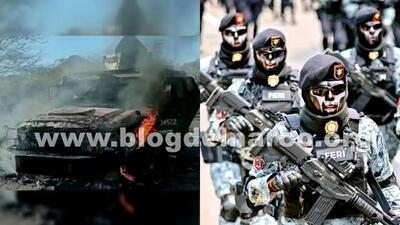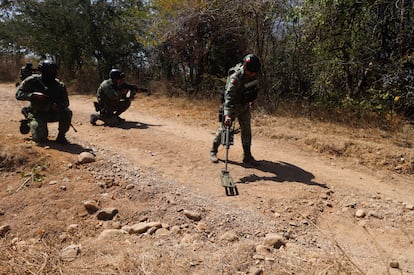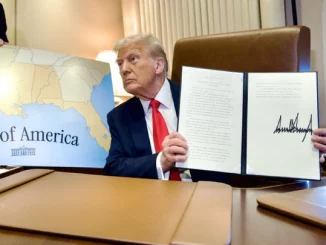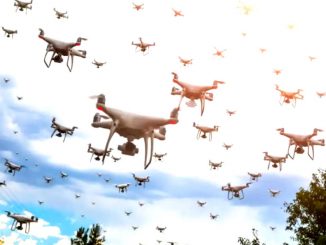
Army personnel demonstrate their search for antipersonnel mines in the municipality of Aguililla, Michoacán, in 2022. ARMANDO SOLIS (AP)
| Published May 29, 2025
The National Guard was patrolling a dirt road in the municipality of Los Reyes when the explosive detonated. Two other soldiers were injured.
a devastating attack in Mexico’s Michoacán state resulted in the deaths of six soldiers and injuries to two others. The incident occurred near the border with Jalisco, a region plagued by violent confrontations between the Jalisco New Generation Cartel (CJNG) and local criminal groups. The soldiers were traveling in an armored vehicle when a roadside improvised explosive device (IED) detonated, marking one of the deadliest such attacks against Mexican military forces in recent years .
The CJNG, known for its aggressive tactics and territorial ambitions, has increasingly employed IEDs and other unconventional weapons, including drones, to assert control over strategic areas. In this case, the explosive device was reportedly planted along a rural path in the El Santuario region of Los Reyes, an area where the CJNG has been active .
This attack underscores the escalating threat posed by cartels’ use of military-grade tactics and weaponry. According to reports, the Mexican army has encountered over 600 IEDs in the Michoacán-Jalisco region, with criminal groups receiving assistance from foreign ex-military personnel in crafting these devices .
In response to the attack, Mexican authorities deployed multiple aircraft and helicopters to the area to recover the fallen soldiers and provide support. The incident has prompted renewed discussions about the need for enhanced strategies to combat the evolving tactics of organized crime in Mexico.
There has been no official clarification from U.S. authorities regarding the newspaper’s mention of “six Texas aircraft and four helicopters.” However, as previously reported, the U.S. has deployed signals reconnaissance aircraft and drones across Mexico—likely in preparation for operations like this one, aimed at disrupting the command-and-control structures of major drug cartels.

Army personnel demonstrate their search for antipersonnel mines in the municipality of Aguililla, Michoacán, in 2022.ARMANDO SOLIS (AP)
The implications of the deadly roadside bomb attack that killed six Mexican soldiers are significant on multiple levels—national security, regional stability, international relations, and the evolving tactics of organized crime:
1. Militarization of Cartel Tactics
-
The use of IEDs and military-grade strategies by cartels like CJNG represents a serious escalation. These are not just criminal acts—they mirror guerrilla warfare and insurgency tactics, challenging the state’s monopoly on force.
2. National Security Challenge
-
Such attacks weaken public confidence in the government’s ability to maintain order.
-
The Mexican military, originally deployed to support local law enforcement, is now increasingly vulnerable, highlighting the need for more advanced counterinsurgency tactics.
3. Destabilization of Key Regions
-
The Michoacán-Jalisco corridor is becoming a war zone, which could lead to population displacement, hinder economic activity, and discourage investment.
-
The fear generated by such violence also makes local governance nearly impossible.
4. International Attention and Pressure
-
The U.S., which shares a border and has significant security cooperation with Mexico, may push for more aggressive anti-cartel measures or offer expanded intelligence and training support.
-
These attacks could also feed into U.S. policy debates on border security and drug trafficking.
5. Strategic Shift in Law Enforcement
-
The repeated use of IEDs suggests that cartels are adapting quickly. Mexican forces may need to rethink their operational protocols, improve surveillance, and invest in bomb detection and disposal units.
-
Intelligence gathering and infiltration of cartels may become a higher priority.
6. Potential for Human Rights Concerns
-
A heavier military response might raise the risk of collateral damage and human rights violations, especially in rural, civilian-populated areas where cartels operate.
Overall Takeaway:
Mexico’s drug war has reached a new level of sophistication and danger, as criminal groups like the CJNG increasingly adopt insurgent tactics—posing a direct challenge to the authority of the state and the effectiveness of conventional law enforcement and military strategies.
This marks a shift from cartel violence as criminal activity to something closer to asymmetric warfare, demanding urgent reevaluation of security policies, regional cooperation, and long-term stabilization efforts. Without decisive action, these tactics may spread, further destabilizing already fragile areas and drawing deeper international concern.
SOURCES: ZEROHEDGE – Six Mexican Soldiers Killed By Cartel Roadside Bomb
MILITARY.COM – Mexican Army Acknowledges Some of Its Soldiers Have Been Killed by Cartel Bomb-Dropping Drones
EL PAIS – A landmine kills six soldiers in an operation on the Michoacán-Jalisco border.
THE TIMES OF INDIA – Six soldiers killed in explosive attack amid ongoing drug cartel violence in Mexico





Be the first to comment